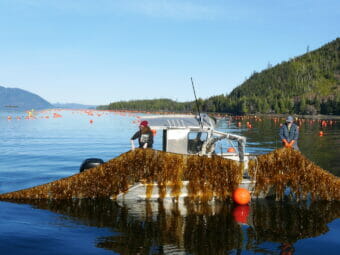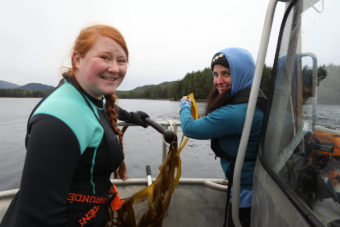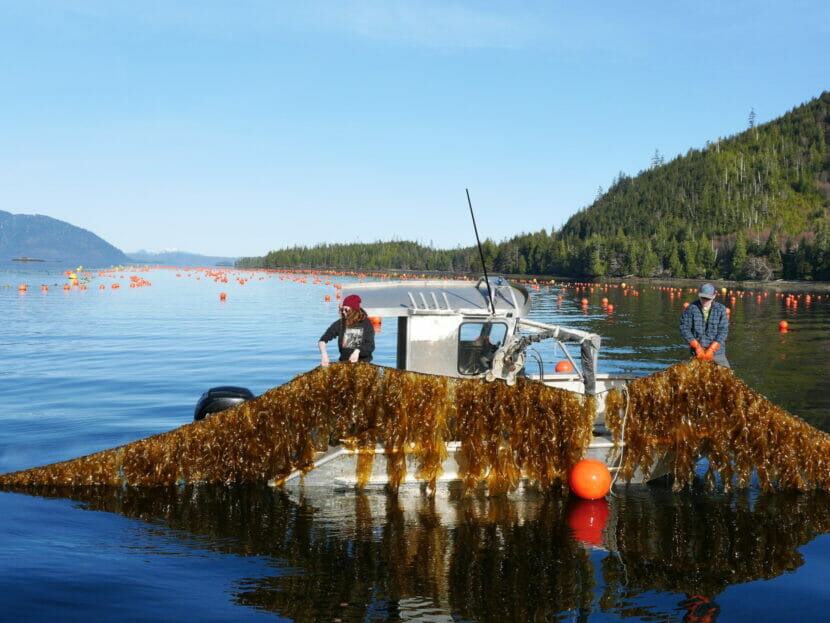
To optimists, the plants that grow in the sea promise to diversify the Alaska economy, revitalize small coastal towns struggling with undependable fisheries and help communities adapt to climate change – and even mitigate it by absorbing atmospheric carbon. Cultivation of seaweed, largely varieties of kelp, promises to buffer against ocean acidification and coastal pollution, the promoters say. Seaweed farms can produce ultra-nutritious crops to boost food security in Alaska and combat hunger everywhere, and not just for human beings.
“Kelp is good for everybody. It’s good for people. It’s good for animals,” Kirk Sparks, with Pacific Northwest Organics, a California company that sells agricultural products, said in a panel discussion at a mariculture conference held in Juneau in February by the Alaska Sea Grant program.
But before it achieves these broad benefits, Alaska’s mariculture industry must first address significant practical issues, including an American consumer market that has yet to broadly embrace seaweed.
Seaweed farming is a bright spot in an Alaska coastal economy roiled by climate change, habitat disruptions and uncertain fish returns.
It is part of an expanding mariculture industry in Alaska that, until recently, was almost exclusively about oyster farming. Commercial seaweed production in the state has grown in volume from virtually zero in 2016 to about 650,000 wet pounds in 2022, according to the Alaska Fisheries Development Foundation.
High hopes
Ambitions for seaweed cultivation and other forms of mariculture are high.
“I want to make Alaska the mariculture capital of the world,” Gov. Mike Dunleavy said at the Juneau conference, an applause-generating line he has used elsewhere.
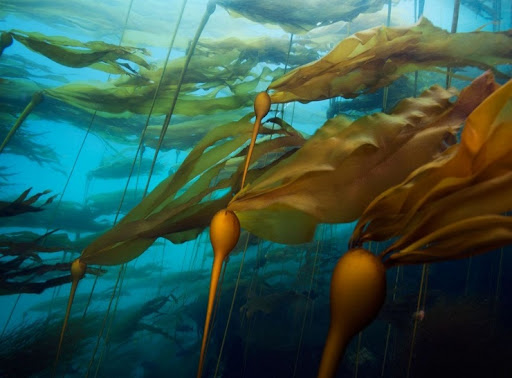
A task force established by Gov. Bill Walker and continued by Dunleavy set a goal for an Alaska industry generating $100 million a year in revenue; in contrast, the nascent Alaska industry was worth only about $1.5 million as of last year, according to the National Oceanic and Atmospheric Administration.
Along with the lofty ambitions, there are high levels of new investment. Through the Democratic-backed American Rescue Plan Act, the U.S. Department of Commerce awarded $49 million to a “mariculture cluster” of Southeast Alaska organizations for projects that include seaweed farming. The Exxon Valdez Oil Spill Trustee Council, the federal-state panel that administers money paid by Exxon Corp. to settle government claims over the massive oil spill, has devoted nearly $32 million to mariculture research and development, focusing on the spill-affected Prince William Sound. Other investments range from $500,000 from the U.S. Department of Agriculture for a mariculture incubator and processing facility to several million dollars appropriated by the Legislature to the University of Alaska for mariculture research and training.
Alaska is currently a long way from being the world’s seaweed-producing capital. The global commercial industry, with an estimated value of $14 billion in 2020, is heavily dominated by Asian countries. Harvested seaweed from Asia goes into a variety of products – for industrial and agricultural use as well as well as for food.
Within the United States, producers in Maine dominate the seaweed-cultivation industry, holding 80% of the market, according to Liz MacDonald of Maine-based Atlantic Sea Farms, who spoke at the Juneau conference.
Products coming from Maine include kelp flakes, kelp seasoning and kelp burgers. A Maine company called Rootless sells bite-sized kelp squares made in five fruity or nutty flavors and marketed as nutrient-packed superfood snacks with slogans like: “Seaweed: The healthiest thing you’re not eating enough of,” and “The mightiest plant on earth comes from the sea.”
Potential benefits aren’t just commercial
While Alaska seaweed farmers are looking to Maine for practical lessons, they are also pointing to potential environmental benefits at home.
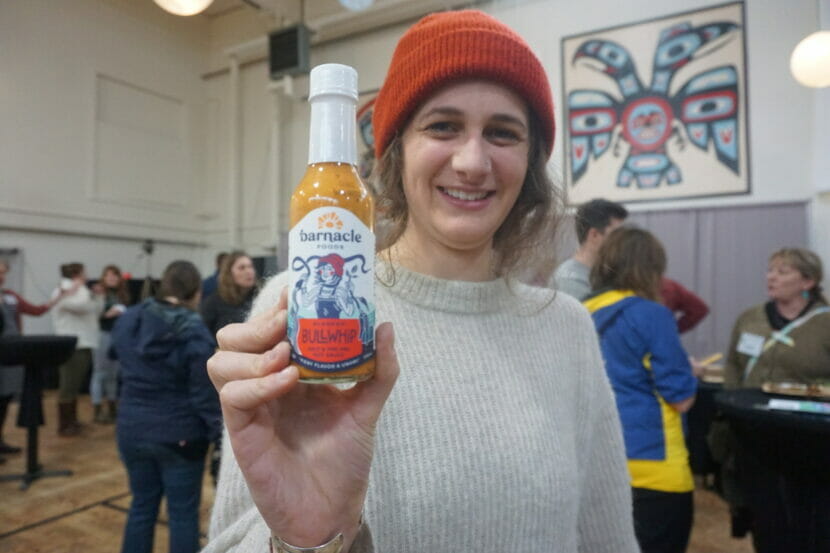
The Walker administration’s 2018 climate action plan invoked mariculture in general and seaweed cultivation, in particular, as a climate adaptation. Mariculture, the plan said, is “an in-place diversification opportunity for small-scale fishermen affected by ocean warming or acidification and communities forced to relocate.”
For Dunleavy, seaweed farming is part of this vision for Alaska to become a leader in the new carbon-sequestration industry, a broad-ranging goal he is pursuing through state legislation. “It’s a new approach, it’s a new process,” the governor said at the Juneau conference. “It’s going to be tremendous in our contribution to that initiative.”
On a local level, farmed kelp appears to reduce pollutants in the water, according to a recent University of Alaska Fairbanks-led study.
There is encouraging scientific evidence that seaweed cultivation buffers acidification locally, as described in studies from various projects, including some from China, California and New York. Seaweed farming “could serve as a low-cost adaptation strategy to ocean acidification and deoxygenation and provide important refugia from ocean acidification,” said the study from China, published in 2021 in the journal Science of the Total Environment.
But does seaweed farming result in absorption of atmospheric carbon and prevention of it streaming back into the atmosphere? The answer is complicated, according to the science. It depends on what happens to the kelp. If dead and decomposing bits are on land or in shallow waters, they would likely release carbon back into the atmosphere, scientists say.
Another environmental consideration involves wild stocks of bull kelp, one of the prime commercial species.
Stocks are so depleted in U.S. West Coast waters that an environmental group, the Center for Biological Diversity, has petitioned for an Endangered Species Act listing, which would be a first for any marine plant. Abundance trends for wild bull kelp vary a lot by location, with numerous problems documented in California, but Alaska’s Aleutian Island region is another trouble spot for wild bull kelp. There, a population crash among sea otters is linked to the kelp decline. Sea otters normally eat sea urchins, and without being held in check by otters, the kelp-eating urchins have been mowing down the underwater forests, according to several scientists.
While climate change, pollution and other problems are considered bigger threats, overharvesting also puts wild kelp at risk, according to the listing petition, currently under review by NOAA’s National Marine Fisheries Service.
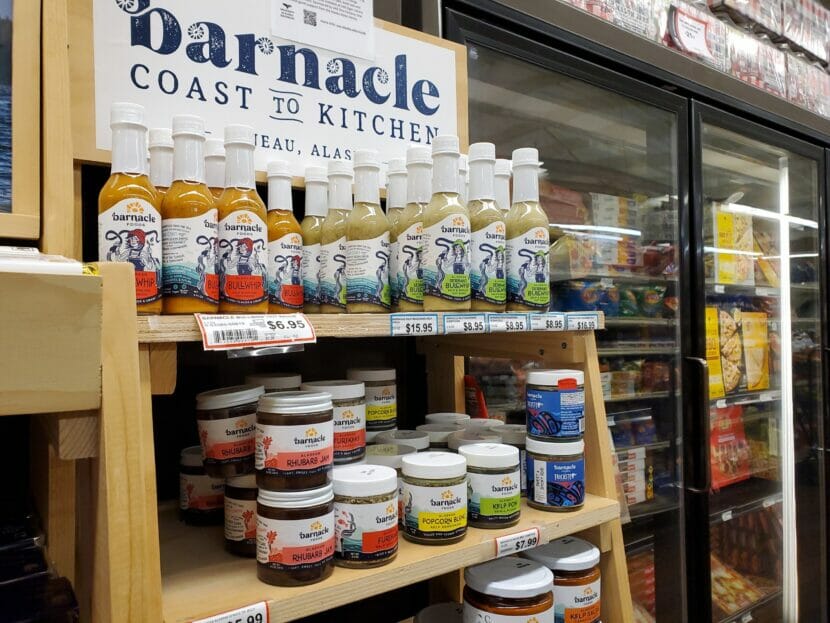
Kelp farming, however, might help restore wild populations, according to some experts. A project in Puget Sound is investigating that possibility.
Several potential environmental downsides to seaweed farming are described in a report published in 2021 in Scotland – another part of the world where seaweed aquaculture is seen as a promising new industry. Among them, according to the report: shading that reduces sunlight needed by other organisms within the water column, possible introduction of invasive species, underwater entanglements of marine mammals and obstructions to travel in the water.
“Whilst there are many socio-economic benefits to be gained from the sustainable development of the seaweed industry, there are also significant risks if the industry is allowed to expand without taking sufficient account of the potential effects on marine ecosystems or the consequences for other legitimate uses of the marine environment,” said the report, which calls for careful planning and impact studies.
Big hurdles
For businesses, there are plenty of economics-related challenges.
One is logistics. Unless companies are manufacturing specialty products, like the kelp-based salsas sold by Juneau’s Barnacle Foods, the project has to be dried; wet plants in bulk are too heavy and thus too expensive to ship from Alaska.
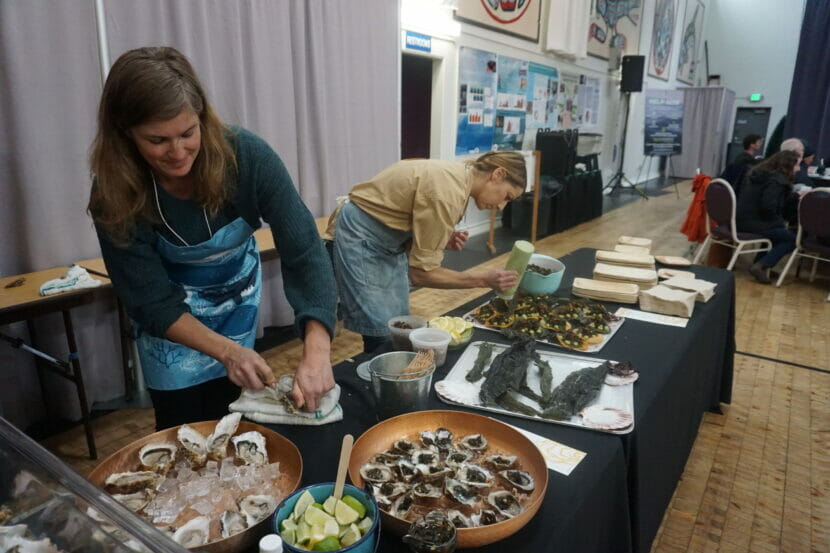
The labor squeeze that is affecting the economy as a whole can also make it difficult for aquaculture operators to attract workers, especially considering the physical rigors of harvesting.
“A lot of the job is pretty wet and cold. It’s definitely one of the hardest parts of this job, we’ve heard from workers,” Weatherly Bates, who owns Alaska Shellfish Farms with her husband Greg, said at the Juneau conference.
Workforce issues aside, the family operation, located in Halibut Cove, has been extremely successful. In 2020, Weatherly and Greg Bates and their two children were named Alaska Farm Family of the Year by the Alaska Division of Agriculture. Local goodwill is such that the family is able to stock a tied-up, unmanned boat in summer to serve as a floating farm stand that gets brisk business – all on the honor system.
Marketing is a big challenge.
Kelp is “a wonderful differentiating ingredient” and “really wonderful for grabbing the attention,” but not everyone is open to eating it, said Matt Kern, co-founder and co-owner of Barnacle Foods, which sells a variety of kelp sauces, condiments and other products.
“We can tell you that there’s not a tidal wave of customers knocking on doors for kelp products,” he said at the Juneau conference. Typical consumers “aren’t necessarily going to choose a kelp product over a non-kelp product, which makes our job a little more challenging. We kind of have an uphill battle to persuade people to give this product a try and include that in their diets.”
The Alaska Seafood Marketing Institute, the state agency that promotes Alaska fish, is unable to help, at least for now.
State law limits ASMI’s promotional work to traditional fish products, said Rep. Dan Ortiz, I-Ketchikan. He has been trying to change that with legislation, but so far has fallen short.
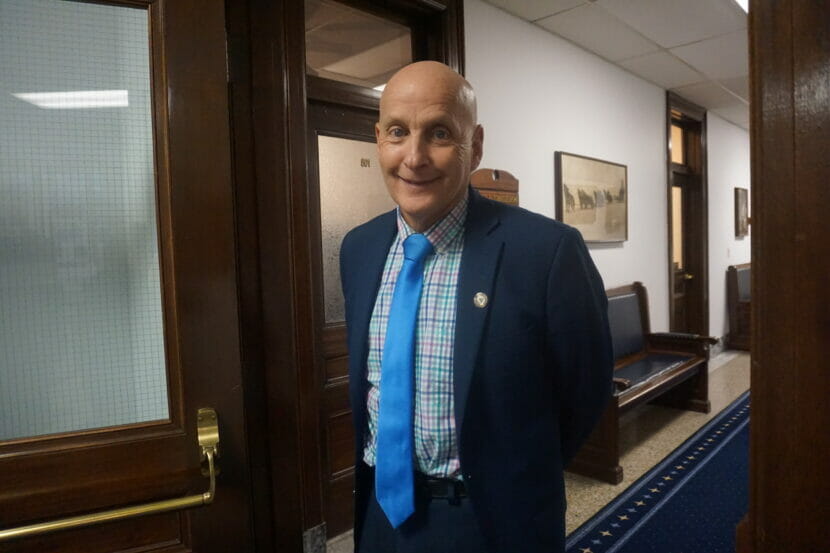
State law limits ASMI’s promotional work to traditional fish products, said Rep. Dan Ortiz, I-Ketchikan. He has been trying to change that with legislation, but so far has fallen short.
A bill he sponsored that the Legislature passed and Dunleavy signed into law last year, House Bill 41, expanded the scope of mariculture projects eligible for state permitting and grant funding. But in a late change in the Senate, a provision that would have granted ASMI authority to promote mariculture products was removed.
While ASMI itself supported expanding its mission to include mariculture, there were objections from parts of the fishing industry, Ortiz said. The issue was funding, he said. ASMI’s operations are paid for, in part, by revenues from a tax levied on harvested fish, and some current donors – from traditional fisheries like salmon – were worried that money promoting mariculture products would be at the expense of the traditional seafood promotions, like notably those for salmon, he said.
“We felt like we tried to alleviate their concerns,” he said, pointing out that the intent was for ASMI to find some federal grants to do the mariculture promotions. Still, it was more important to get the rest of the bill passed than to fight for that particular provision, he said. He is now working with people in the mariculture sector to try to find a future path for product promotion, which might mean future legislation, possibly as soon as this year, he said.
Ortiz admits to being a relatively recent seaweed convert himself and someone who needed a little marketing-type persuasion.
“Five years ago, I thought that was weird. ‘How’s that going to taste?’” But then he tried kelp. “It tasted great.”
Others have followed a similar path, embracing seaweed cultivation for both economic and environmental reasons, he said. “There’s a growing acceptance that, hey, there’s a lot of potential out there in the ocean for a variety of foods,” he said. “The sky’s the limit.”
Success involves getting more converts like himself, he said. “Part of that is being able to get mariculture products marketed worldwide through ASMI and other venues.”
Indigenous food and rights
Seaweed is a traditional Alaska Native food, with no such marketing outreach needed. That leads to some wariness in Indigenous communities about the proliferation of kelp farms.
Jim Smith, restoration manager for the Cordova-based Native Conservancy, expressed some of those concerns at last month’s conference.
“Be mindful of what you’re asking kelp to do for you. Be mindful of the water you’re asking your permits to occupy before you ask Indigenous people to share their knowledge,” he told the conference audience.
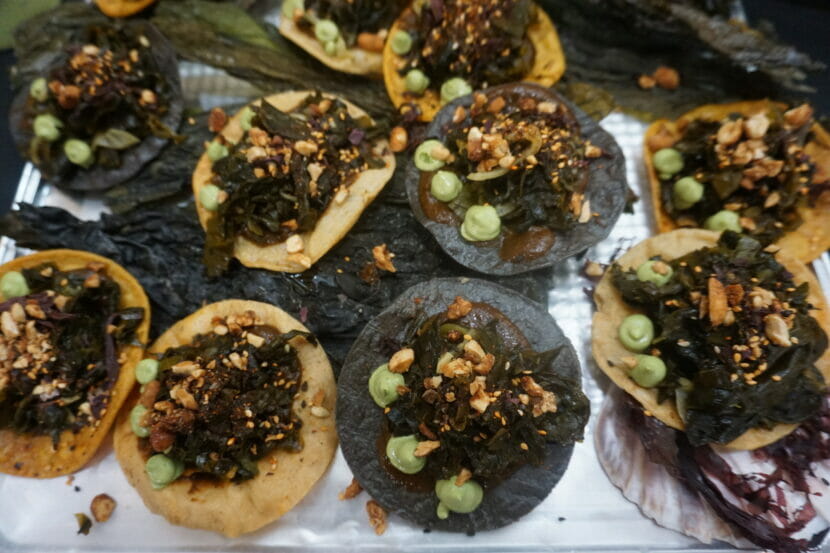
The land trust organization, which is affiliated with the Eyak Preservation Council, was established 20 years ago with the goal of permanently protecting and preserving endangered habitats in the Eyak ancestral region – a region heavily impacted by the Exxon Valdez oil spill. Among its programs is kelp farming: It is already underway, as are numerous research projects. The Native Conservancy has a goal of creating or helping to create 100 20-acre Native-owned kelp farms in the region, with potential to grow 30 million pounds, to serve as a model for other regions in Alaska.
Native ownership and Native control are crucial, Smith said in an interview.
There are worries that what has happened with limited-entry and quota-share fishing will be repeated with seaweed farming, he said. He has watched over time as Eyak tribal members were crowded out of Prince William Sound fisheries, leaving him as one of the last remaining Eyak permit-holders fishing in the Copper River Delta.
Kelp is wonderful, with almost “magical” qualities of nutrition and healing, Smith said. But it has its limits.
“It doesn’t solve the problems that got us here, the exploitation, the colonization,” he said. While seaweed farming may be the “latest cool development” among the general public, high hopes could backfire on Indigenous people if the development is not done correctly, he said.
“It’s a lot of pressure on kelp. It’s a lot of pressure on Indigenous people,” he said.
This story originally appeared in the Alaska Beacon and is republished here with permission.


